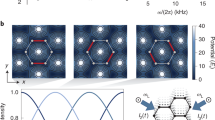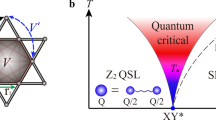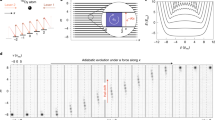Abstract
Strongly interacting topological matter1 exhibits fundamentally new phenomena with potential applications in quantum information technology2,3. Emblematic instances are fractional quantum Hall (FQH) states4, in which the interplay of a magnetic field and strong interactions gives rise to fractionally charged quasi-particles, long-ranged entanglement and anyonic exchange statistics. Progress in engineering synthetic magnetic fields5,6,7,8,9,10,11,12,13,14,15,16,17,18,19,20,21 has raised the hope to create these exotic states in controlled quantum systems. However, except for a recent Laughlin state of light22, preparing FQH states in engineered systems remains elusive. Here we realize a FQH state with ultracold atoms in an optical lattice. The state is a lattice version of a bosonic ν = 1/2 Laughlin state4,23 with two particles on 16 sites. This minimal system already captures many hallmark features of Laughlin-type FQH states24,25,26,27,28: we observe a suppression of two-body interactions, we find a distinctive vortex structure in the density correlations and we measure a fractional Hall conductivity of σH/σ0 = 0.6(2) by means of the bulk response to a magnetic perturbation. Furthermore, by tuning the magnetic field, we map out the transition point between the normal and the FQH regime through a spectroscopic investigation of the many-body gap. Our work provides a starting point for exploring highly entangled topological matter with ultracold atoms29,30,31,32,33.
This is a preview of subscription content, access via your institution
Access options
Access Nature and 54 other Nature Portfolio journals
Get Nature+, our best-value online-access subscription
$29.99 / 30 days
cancel any time
Subscribe to this journal
Receive 51 print issues and online access
$199.00 per year
only $3.90 per issue
Buy this article
- Purchase on Springer Link
- Instant access to full article PDF
Prices may be subject to local taxes which are calculated during checkout





Similar content being viewed by others
Data availability
The data that support the findings of this study are available in the Dataverse repository at https://doi.org/10.7910/DVN/2XDSA4.
References
Wen, X. G. Quantum Field Theory of Many-Body Systems (Oxford Univ. Press, 2007).
Kitaev, A. Y. Fault-tolerant quantum computation by anyons. Ann. Phys. 303, 2–30 (2002).
Nayak, C., Simon, S. H., Stern, A., Freedman, M. & Das Sarma, S. Non-Abelian anyons and topological quantum computation. Rev. Mod. Phys. 80, 1083–1159 (2008).
Giuliani, G. & Vignale, G. Quantum Theory of the Electron Liquid (Cambridge Univ. Press, 2012).
Madison, K. W., Chevy, F., Wohlleben, W. & Dalibard, J. Vortex formation in a stirred Bose-Einstein condensate. Phys. Rev. Lett. 84, 806 (2000).
Schweikhard, V., Coddington, I., Engels, P., Mogendorff, V. & Cornell, E. Rapidly rotating Bose-Einstein condensates in and near the lowest Landau level. Phys. Rev. Lett. 92, 040404 (2004).
Zwierlein, M. W., Abo-Shaeer, J. R., Schirotzek, A., Schunck, C. H. & Ketterle, W. Vortices and superfluidity in a strongly interacting Fermi gas. Nature 435, 1047–1051 (2005).
Cooper, N. R. Rapidly rotating atomic gases. Adv. Phys. 57, 539–616 (2008).
Lin, Y.-J., Compton, R. L., Jiménez-García, K., Porto, J. V. & Spielman, I. B. Synthetic magnetic fields for ultracold neutral atoms. Nature 462, 628–32 (2009).
Jotzu, G. et al. Experimental realization of the topological Haldane model with ultracold fermions. Nature 515, 237–240 (2014).
Aidelsburger, M. et al. Measuring the Chern number of Hofstadter bands with ultracold bosonic atoms. Nat. Phys. 11, 162–166 (2015).
Mancini, M. et al. Observation of chiral edge states with neutral fermions in synthetic Hall ribbons. Science 349, 1510–1513 (2015).
Kennedy, C. J., Burton, W. C., Chung, W. C. & Ketterle, W. Observation of Bose–Einstein condensation in a strong synthetic magnetic field. Nat. Phys. 11, 859–864 (2015).
Tai, M. E. et al. Microscopy of the interacting Harper–Hofstadter model in the two-body limit. Nature 546, 519–523 (2017).
An, F. A., Meier, E. J. & Gadway, B. Direct observation of chiral currents and magnetic reflection in atomic flux lattices. Sci. Adv. 3, e1602685 (2017).
Roushan, P. et al. Chiral ground-state currents of interacting photons in a synthetic magnetic field. Nat. Phys. 13, 146–151 (2017).
Cooper, N. R., Dalibard, J. & Spielman, I. B. Topological bands for ultracold atoms. Rev. Mod. Phys. 91, 15005 (2019).
Asteria, L. et al. Measuring quantized circular dichroism in ultracold topological matter. Nat. Phys. 15, 449–454 (2019).
Ozawa, T. et al. Topological photonics. Rev. Mod. Phys. 91, 15006 (2019).
Mukherjee, B. et al. Crystallization of bosonic quantum Hall states in a rotating quantum gas. Nature 601, 58–62 (2022).
Zhou, T.-W. et al. Observation of universal Hall response in strongly interacting fermions. Preprint at http://arxiv.org/abs/2205.13567 (2022).
Clark, L. W., Schine, N., Baum, C., Jia, N. & Simon, J. Observation of Laughlin states made of light. Nature 582, 41–45 (2020).
Laughlin, R. B. Anomalous quantum Hall effect: an incompressible quantum fluid with fractionally charged excitations. Phys. Rev. Lett. 50, 1395–1398 (1983).
Hafezi, M., Sørensen, A. S., Demler, E. & Lukin, M. D. Fractional quantum Hall effect in optical lattices. Phys. Rev. A 76, 023613 (2007).
Palmer, R. N., Klein, A. & Jaksch, D. Optical lattice quantum Hall effect. Phys. Rev. A 78, 013609 (2008).
Möller, G. & Cooper, N. R. Composite fermion theory for bosonic quantum Hall states on lattices. Phys. Rev. Lett. 103, 105303 (2009).
Scaffidi, T. & Möller, G. Adiabatic continuation of fractional Chern insulators to fractional quantum Hall states. Phys. Rev. Lett. 109, 246805 (2012).
Repellin, C., Léonard, J. & Goldman, N. Fractional Chern insulators of few bosons in a box: Hall plateaus from center-of-mass drifts and density profiles. Phys. Rev. A 102, 063316 (2020).
Grusdt, F., Yao, N. Y., Abanin, D., Fleischhauer, M. & Demler, E. Interferometric measurements of many-body topological invariants using mobile impurities. Nat. Commun. 7, 11994 (2016).
Sterdyniak, A., Regnault, N. & Möller, G. Particle entanglement spectra for quantum Hall states on lattices. Phys. Rev. B 86, 165314 (2012).
Račiunas, M., Ünal, F. N., Anisimovas, E. & Eckardt, A. Creating, probing, and manipulating fractionally charged excitations of fractional Chern insulators in optical lattices. Phys. Rev. A 98, 063621 (2018).
Muñoz de las Heras, A., Macaluso, E. & Carusotto, I. Anyonic molecules in atomic fractional quantum Hall liquids: a quantitative probe of fractional charge and anyonic statistics. Phys. Rev. X 10, 41058 (2020).
Palm, F. A. et al. Bosonic Pfaffian state in the Hofstadter-Bose-Hubbard model. Phys. Rev. B 103, L161101 (2021).
Gemelke, N., Sarajlic, E. & Chu, S. Rotating few-body atomic systems in the fractional quantum Hall regime. Preprint at https://arxiv.org/abs/1007.2677 (2010).
Eckardt, A. Colloquium: Atomic quantum gases in periodically driven optical lattices. Rev. Mod. Phys. 89, 011004 (2017).
Palm, L., Grusdt, F. & Preiss, P. M. Skyrmion ground states of rapidly rotating few-fermion systems. New J. Phys. 22, 083037 (2020).
Barkeshli, M., Yao, N. Y. & Laumann, C. R. Continuous preparation of a fractional Chern insulator. Phys. Rev. Lett. 115, 026802 (2015).
Motruk, J. & Pollmann, F. Phase transitions and adiabatic preparation of a fractional Chern insulator in a boson cold-atom model. Phys. Rev. B 96, 165107 (2017).
He, Y. C., Grusdt, F., Kaufman, A., Greiner, M. & Vishwanath, A. Realizing and adiabatically preparing bosonic integer and fractional quantum Hall states in optical lattices. Phys. Rev. B 96, 201103(R) (2017).
Bakr, W. S., Gillen, J. I., Peng, A., Fölling, S. & Greiner, M. A quantum gas microscope for detecting single atoms in a Hubbard-regime optical lattice. Nature 462, 74–77 (2009).
Kane, C. L., Mukhopadhyay, R. & Lubensky, T. C. Fractional quantum Hall effect in an array of quantum wires. Phys. Rev. Lett. 88, 036401 (2002).
Widom, A. Thermodynamic derivation of the Hall effect current. Phys. Lett. 90, 474 (1982).
Streda, P. Quantised Hall effect in a two-dimensional periodic potential. J. Phys. C Solid State Phys. 15, L717–L721 (1982).
Umucalilar, R. O., Zhai, H. & Oktel, M. Ö. Trapped Fermi gases in rotating optical lattices: realization and detection of the topological Hofstadter insulator. Phys. Rev. Lett. 100, 070402 (2008).
Repellin, C. & Goldman, N. Detecting fractional Chern insulators through circular dichroism. Phys. Rev. Lett. 122, 166801 (2019).
Cian, Z. P. et al. Many-body Chern number from statistical correlations of randomized measurements. Phys. Rev. Lett. 126, 50501 (2021).
Viebahn, K. et al. Suppressing dissipation in a Floquet-Hubbard system. Phys. Rev. X 11, 11057 (2021).
Zupancic, P. et al. Ultra-precise holographic beam shaping for microscopic quantum control. Opt. Express 24, 13881–13893 (2016).
Islam, R. et al. Measuring entanglement entropy in a quantum many-body system. Nature 528, 77–83 (2015).
Sterdyniak, A., Regnault, N. & Bernevig, B. A. Extracting excitations from model state entanglement. Phys. Rev. Lett. 106, 100405 (2011).
Regnault, N. & Jolicoeur, T. Quantum Hall fractions for spinless bosons. Phys. Rev. B Condens. Matter Mater. Phys. 69, 235309 (2004).
Haldane, F. D. Fractional quantization of the Hall effect: a hierarchy of incompressible quantum fluid states. Phys. Rev. Lett. 51, 605–608 (1983).
Möller, G. & Cooper, N. R. Fractional Chern insulators in Harper-Hofstadter bands with higher Chern number. Phys. Rev. Lett. 115, 126401 (2015).
Acknowledgements
We acknowledge fruitful discussions with B. Bakkali-Hassani, I. Carusotto, N. Cooper, J. Dalibard, A. Eckardt, S. Girvin, M. Hafezi, J. Ho, M. Lebrat, F. Palm, N. Ünal, K. Viebahn and M. Zwierlein. We are supported by grants from the National Science Foundation, the Gordon and Betty Moore Foundation’s EPiQS Initiative, an Air Force Office of Scientific Research MURI programme, an Army Research Office MURI programme, the Swiss National Science Foundation (J.L.) and the NSF Graduate Research Fellowship Program (S.K.). F.G. acknowledges funding by the DFG through Research Unit FOR 2414 (project number 277974659) and through EXC-2111 (project number 390814868), and from the ERC through the European Union’s Horizon 2020 (grant agreement no 948141). N.G. acknowledges funding through the EOS project CHEQS, the FRS-FNRS and the ERC grants TopoCold and LATIS.
Author information
Authors and Affiliations
Contributions
J.L., S.K., J.K. and P.S. contributed to conducting the experiment, collecting and analysing the data and performing the numerical calculations. J.L. proposed the experiment and performed supporting theoretical studies together with F.G., C.R. and N.G. All authors contributed to writing the manuscript and to discussions. M.G. supervised the work.
Corresponding author
Ethics declarations
Competing interests
M.G. is cofounder and shareholder of QuEra Computing. All other authors declare no competing interests.
Peer review
Peer review information
Nature thanks David Feder and the other, anonymous, reviewer(s) for their contribution to the peer review of this work. Peer reviewer reports are available.
Additional information
Publisher’s note Springer Nature remains neutral with regard to jurisdictional claims in published maps and institutional affiliations.
Extended data figures and tables
Extended Data Fig. 1 Sequence.
Full sequence for the performed experiments. All parameters are given for the driven Bose–Hubbard Hamiltonian (not the effective Hamiltonian).
Extended Data Fig. 2 Coherence time.
a, Long-term evolution of an atom under 1D Raman tunnelling. The atom initially occupies site 0. The tunnelling along x is set to K/2π = 13 Hz (smaller than for the main measurements) and the tilt along x is Δx/2π = 40 Hz per site. The tilt leads to a rephasing of the quantum walk and converts it to Bloch oscillations, which show coherent revivals after the evolution times of 500 ms. The evolution is in agreement with a fit to the data, which incorporates decoherence through the Monte Carlo wavefunction technique. b, Cut through the data in a of the initial site 0. The fit result (solid line) yields a decay rate of τRaman = 1.25(7) s. Error bars denote the s.e.m.
Extended Data Fig. 3 Excited-state populations.
a, Protocol for measuring the full density distribution in the left two columns. We project a repulsive wall potential between the left two columns and enable tunnelling along the horizontal direction, thereby ejecting the atoms into half-rows and breaking up potential doublons. This allows us to identify the populations of the lowest 36 Fock states in energy. Fock states that are higher in energy involve at least one atom in the right two columns; their populations are allotted to their low-energy counterpart with both atoms in the left two columns. b, Excited-state populations. Inferred excited-state overlap \(\langle {\psi }_{i}| {\hat{\rho }}_{{\rm{Final}}}| {\psi }_{i}\rangle \) of the prepared state \({\hat{\rho }}_{{\rm{Final}}}\) with the eigenstates |ψi〉 of the final Hamiltonian. We find a dominant population in the ground state and most of the excited-state population in the lowest few eigenstates.
Extended Data Fig. 4 System-size scaling.
Numerical system-size scaling of the observed FQH signatures for N = 2 particles in quadratic box potentials. Left panels show data for a 3 × 3 system and right panels show the behaviour when increasing the length L of the system. a, Energy-gap diagram with a gap closing at the flux ϕc/2π for tunnelling K/J = 1. For each system size, we compute the corresponding filling factor using νc = ρBulk/(ϕc/2π) (right panel). b, Doublon fraction with suppression at ϕc/2π. We extract the ratio \({p}_{{\rm{Doublon}}}^{{\rm{FQH}}}/{p}_{{\rm{Doublon}}}^{{\rm{Normal}}}\) from the doublon fraction \({p}_{{\rm{Doublon}}}^{{\rm{FQH}}}\) in the FQH state and \({p}_{{\rm{Doublon}}}^{{\rm{Normal}}}\) in the normal state, each extracted over an interval of Δϕ = 0.1 × ϕc. c, The reduced density correlations show already the vortex pattern for the 3 × 3 system (left panel). As the system size is increased, the correlations for neighbouring sites (|d| = 1), dark blue) approach zero and the correlations at a distance of 3lB (light blue, similar to Fig. 4c) stabilize at a value between one and two. d, Increase of the bulk density and extracted Hall conductivity σH/σ0 from a linear fit by means of Středa’s formula. When increasing the system size, the obtained Hall conductivity converges to σH/σ0 = 1/2.
Extended Data Fig. 5 Orbital occupations and topological properties for systems with N = 2 and N = 4 bosons.
a, We first consider a system with N = 4, U = 8J and 7 × 7 lattice sites. The many-body spectrum shows several local minima between the ground state and the first excited state (dark red), which we interpret as finite-size signatures of phase transitions. In the range 0.20 < ϕ/2π < 0.3, between two such minima, the occupations of the single-particle orbitals (histograms) approximately match the expectation for a Laughlin state. This interpretation is reinforced by the PES, which shows a gap between the lowest 15 eigenstates (red) and all higher-lying states (blue), indicating (quasi-)degenerate quasi-hole states that identify the Laughlin state. b, For a system with N = 2, U = 8J and 4 × 4 lattice sites, we find only a single local minimum between the ground state and the first excited state (ϕ/2π ≈ 0.25), which we interpret as the transition from the normal to FQH states. This is confirmed by the large overlap of the ground-state occupations of the single-particle orbitals with the Laughlin state. For the N = 2 system, an identification of the topological signatures in FQH states with the PES is not possible.
Supplementary information
Rights and permissions
Springer Nature or its licensor (e.g. a society or other partner) holds exclusive rights to this article under a publishing agreement with the author(s) or other rightsholder(s); author self-archiving of the accepted manuscript version of this article is solely governed by the terms of such publishing agreement and applicable law.
About this article
Cite this article
Léonard, J., Kim, S., Kwan, J. et al. Realization of a fractional quantum Hall state with ultracold atoms. Nature 619, 495–499 (2023). https://doi.org/10.1038/s41586-023-06122-4
Received:
Accepted:
Published:
Issue Date:
DOI: https://doi.org/10.1038/s41586-023-06122-4
This article is cited by
-
Evidence for chiral graviton modes in fractional quantum Hall liquids
Nature (2024)
-
Exploring large-scale entanglement in quantum simulation
Nature (2023)
-
Topological quantum tango
Nature Physics (2023)
-
Quantized valley Hall response from local bulk density variations
Communications Physics (2023)
-
Observation of frustrated chiral dynamics in an interacting triangular flux ladder
Nature Communications (2023)
Comments
By submitting a comment you agree to abide by our Terms and Community Guidelines. If you find something abusive or that does not comply with our terms or guidelines please flag it as inappropriate.



